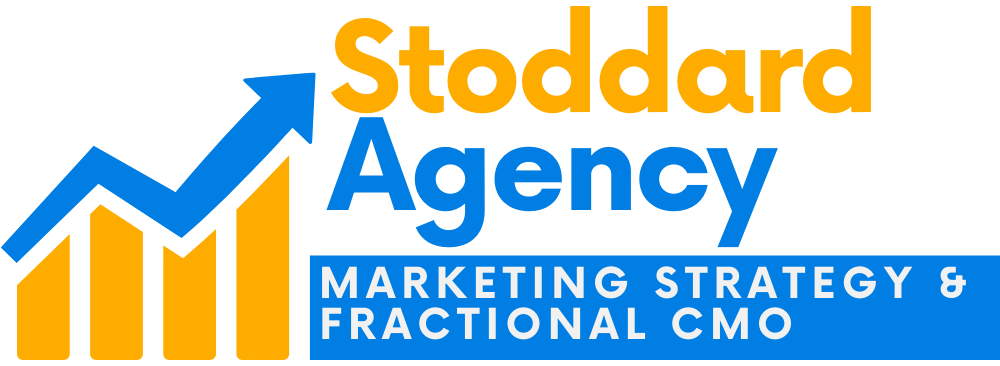
Show Transcript
Hey there. Good morning. Good afternoon. Good evening. Whenever it is that you’re watching this, I am Jesse Stoddard, your friendly neighborhood, fractional CMO. If you are a home services or trades contractor business owner, you’re going to really enjoy this free tutorial today called scaling a home services business into a multi-state powerhouse. This is actually technically me documenting my fractional CMO journey with a couple of clients. I figured I would show you under the hood, let you see behind the scenes to understand what really happens when you start to grow a business. Especially if you’re trying to achieve at least 10 to 20 million. And this particular segment is part three. I call it marketing math 2.0. Why listen to me about this topic by the way? First of all, I used what I’m about to show you to help a home services business owner make an extra $4 million in one year.
They went from 13.8 to 17.8 and that was a pretty good year. This will ultimately help you save money and make better decisions. And this will help you to take command of your advertising budget, and this will help you to make more informed decisions when it comes to marketing and marketing people or agencies. All right. Warning. Yes. Math nerd stuff ahead again. I know this is another one with a lot of math, but it’s not very complicated math and really the formulas are simple, right? Don’t worry. In fact, I’ve seen the finance partner in a home services business try to overcomplicate this unnecessarily and lose focus on the main thing. The following exercise will help you figure out exactly how many leads you need to get in order to meet your revenue goals. It’ll help you do a lot of things, and this is needed to help come up with a budget and more importantly, determine which media to focus on in that budget.
And this will help guide you and all of your marketing decisions from here until you arrive at your destination and therefore it is important. All right. The almighty forecasting tool, we’re talking about the forecasting tool and my big mugs in the way. You can see what I’m talking about here. Why use the forecasting tool? All right. Well, first of all, there’s a couple things. You must know your past and current numbers. If you want to scale and grow all right, revenue by month for the last few years, at least. Go look that up. You can pause this video or come watch it again. Later, the average sale, okay. The average revenue generated per transaction. Basically remember that CAC customer acquisition cost calculator. I covered in the last video, these two videos, these two lessons intersect and combine and create synergy. If you put them together, you’re going to need your closing percentage, your average closing percentage of your sales reps, or customer service reps or whatever you call ’em. You need your average revenue generated per sales person.
Just look at how much volume that you did. And if you have $10 million volume and you have 10 sales people, then the average guy produced a million, right? Something like that, some rough number, The number of jobs you can do in a day, that’s important because every business is a little different here. If you are in, you know, remodeling, and these projects may be really long. If you’re in more of a quick home service in and out in the same day, it’s very different. You’re going to get different results, obviously with the numbers. You have to weigh those two things and you’ll be able to determine what targets you need to hit to meet your goals. That’s the other big one, the number of sales reps and crews that are needed, and the number of sales qualified leads you’ll need.
That’s the big benefit of using the forecasting tool. Okay. And then the number of marketing qualified leads or prospects you’ll need, because you’re going to need a certain number of when I call marketing, qualified just means that the marketing team did their job. You know, they gotta lead to the website. Somebody filled out a form, right. Or they, or a phone call comes in. Okay, well that’s fine, but it’s not sales qualified until they actually have set an appointment to meet with your salesperson, for their inspection, for their bid, for their estimate, for whatever your process is. After that, that’s a sales Qualified lead. It’s on the books, right? And now it’s up to a salesperson to close it. Okay. That’s different. You’re going to need a lot more prospects to get the leads that you want. And then pardon my picture being in the way again, the estimated marketing budget, if you also did the CAC calculator you’ll know all there is to know for forecasting and setting your KPI.
Again, these two lessons go together. All right. Now the, before numbers of we’re going to look at the last two years, typically, if you are brand new and you’re already looking at videos like this, well, I commend you. This will be planning for the future. But if you have at least two years of records, this is going to be much more useful to you because the way that we’re looking at predictions for the future is looking at the past. And just like, by the way, I should leave a disclaimer, it should be obvious that’s just like in the financial world, that past performance does not necessitate equal or promise future performance, right? We have to remember that, but we’re looking for a rule, a rule of thumb, you know, kind of general guidance. And that works for that. It’s really, really good.
This is a sheet that’s customized for a particular business, but we’re going to learn lessons from it so you can create your own. All right. With this particular business, and these are real numbers from a particular business. And I pulled something from a long time ago, so that we’re not worried about what’s happening now, that’s recent news, but we’re going to look at 2007, 2016, and you can see there, every month’s revenue is listed for the whole year with totals. We have our total revenue on the the right column and the increase that happened each year and the percentage of growth, and we have it from 2007 to 16 and then at the bottom, everything is based on the last two years. The average of the last two years of revenue and the growth between the prior year and the more recent year and the figure, the percentage of growth per month and the leads for that year, the first year.
I’m going to go over that. The average of the last two years between 864,000 and change, and 853 was 859. This number is the average between these two years, and this is the growth from the 2015 to 16 timeframe. You’ll see that a couple months in Jan, January was negative 1%, not too far off about the same, right? 11% growth in February 20, in March negative two, in April negative eight, in May negative one, negative 15 in July, which was real bad, but then a positive 21 positive 33, 5 28 21. You’ll notice this was a really great time to take numbers because if you look at the numbers before that, there was almost always steady growth. It was incredible growth. And then that year was a bad year. Now I’m not going to go into why they had some problems with, I’ll just say the HR and employee situation due to the type of employees that were coming in and needing more documentation, I believe.
But there was other factors, there was economic factors. We’re coming off of a recession in 2008 and yet we were growing anyway. Even that was an anomaly. Every business is different, right? And if you look at the right, we have a $3 million year, a 4 million, a 5 million, 5, 7, 9, 11, 12, and up to 13.8 and you’ll notice some years, 29, 30% growth, some years, 5 20, 1 33, 25, 5, 1 11. Right? They had some huge growth years interspersed with some not so good years, but you know, coming off of 2007 and eight, that’s amazing. Right? That is amazing. Below the percentage by month is the percentage of the actual income that came in in that month or, or compared to the rest of the year. In other words, 6.4, 7% of all of the revenue for the year came in January and all the way up.
And you’ll notice that the highest month was 10.9 7% of all of their revenue was created in October. All right. Now what, when, if you look at the trend in this business, you see that they get a boost in the fall late summer, you know, late summer and the fall moving into winter is their peak month, but it slows down in the December Christmas holiday. And then it tanks January, February, March, right? And doesn’t start picking up until late. You know, the spring is kind of slow too, in this particular business. Now it’s never ridiculously slow. It’s not like no business is coming in. It’s just that the amount of revenue is heavily weighted toward October, November and, and September. Actually August is pretty good too. Now you also need to think the lag time of the leads because the leads, if you look at the leads below it, in that prior year, the leads that were coming in were pretty steady, but there was a big, it increased steadily in the summer and in the early fall.
And you’ll notice that there’s not a lot of lag time in this business, but maybe a little bit maybe delay by up to a month. In other words, you get a lot of leads in you get a lot of leads in September and it produces some volume in September, some of the revenues in September, because these, by the way, in this business, usually you get a lead and you would close it that week. And then the job is done the next week, right? There’s not a huge lag time. It’s not like this is a sales cycle, like in B2B where it could be six months before you make a sale. It’s usually pretty quick. It’s a one day, you know, one call close in many cases, right? Your business may be slightly different from that. But the idea here is you need to look at both the leads and, you know, the trailing revenue.
And you can see also in that month, there were also more leads in October. Okay. The greatest number of leads happen in October and the greatest percentage of the actual revenue is in October. That alone is reason to do a study like this so that you can see what the fluctuations are seasonally, and you probably intuitively already know it. You know, if you’ve been in business for any amount of time, you already know intuitively without even looking at the numbers, but you want to validate with the numbers, you’re your hunches, because your hunches aren’t always right. Okay. Now let’s break it down into more detail and go further into the sheet because there’s more to it. If we look at the, at the lower left here, okay. A little bit of this review, but the average of the last two years coming out of a slower year.
In 2015, which was a little bit slower compared to the prior 2014 year, we’re also paying special attention to the number of leads we discussed that already. Okay. We’re looking at the trend now. It’s important to note the revenue increases per year. And per month and the seasonality of where more of the revenue’s coming from. We also talked about that. Taking a quick look at that again. Now more leads are coming in late summer and fall with revenue trailing only a little behind with the peak in October. We’ve learned that as well. You’re going to want to do the same for your business, but we’re going to use this as an example. We’re thinking, what do we learn from this? Well, what we can start doing is goal setting. On the far right of the spreadsheet, which I didn’t show you in the previous pictures, there are the goals on the far right.
And actually I’m going to take a minute here and explain that you can see right here, the green, the spreadsheet I’m on the right side. At the end of those totals of all of that revenue and the growth that we, we talked about beyond that, there’s a couple extra columns where we decided to do goal setting. So of all this calculator is really simple. You can plug in a number here 40%. And the math equation for here is simple. We take whatever we did this year. And then next year we’re going to add 40%. And then 40% on top of that. And 40%, obviously this is considerable, you know, growth that it becomes a hockey stick. You know, we’re almost exponential growth here, geometric right? Cause we’re doing 40% on top of 40%. We’ve got the compound interest thing going. This company in 10 years could theoretically, if it could maintain 40% growth, be 401 million, right?
That’s aggressive growth, especially in today’s economy. We don’t know right now, maybe this year post COVID everybody’s buying customers are lined up and stacked up. It’s easy. Right. But that changes as you know, everything is seasonal. Everything is seasonal. With that being said, we know that in the next couple years in, in 16, well actually the in 17 and 18, which is what we’re really focusing on is we have a goal here of this 40% growth, which gets us maybe up to 27. The next year would be 19 million, 430, 2,302 would be our goal. That’s one year out from where this particular sheet starts. Let’s talk about forecasting now with that. A couple things to keep in mind here. If we’re looking at the bottom of this sheet, there’s another roll column and I’ll show you the whole thing at the end here, just to kind of pull it all together.
But below those numbers of each month of January, February, March, April, what we did is a forecast. We said, okay, if that’s true of those 2015 and 16, what could we, what could we forecast for 2017? Right? What’s the revenue forecast? What’s the actual in 2016 and then the growth that would be from 16 to 17 and then the 2017 actual. Now you see at the time of building the sheet, we didn’t put the actuals in because I took this sheet before it was completed from our example. But I can tell you that this end number was 13.8. We didn’t quite hit the 19.4 goal, but the 13, 0.8 was the actual in that year. And the 2017, was 17.8. Forgive me. So we hit almost 18 million when we were shooting for 19 with, as a stretch goal.
Right. That’s pretty good. That is pretty darn good. Because we’re shooting that. I mean, that’s a stretch goal. Some of these years we got 5% negative, 1% growth, 20% growth was considered success, right? We definitely had success because we set these goals using the previous ROI. The customer acquisition cost calculator. And then also this forecasting, this is how we did it. This is how we set up our goals and figured out what we needed to do. With the actuals here, the forecast of growth, and this is our percentage growth that we achieved. And you can see right here, we don’t have these numbers at the end, but we were looking for at least 20%. Did we hit 20% every month, 47, 39, 27. Still hit it. Even though that was considered quite unquote, low 32, a whopping 71%. What’s interesting to note about this is this January, February, March, April, May.
That’s not even a month that we’re supposed to do well, that’s not even a month that we’re, that we were planning to do. Well, May, June, July, August, September, October. And now the business owner in this case, I’m not going to get into it too much, but they were upset because October wasn’t as high as they were hoping, I think it was only 20% growth and they were hoping for like 80% and they went out and bought a bunch of trucks and that’s not, you know, that’s a whole different story. Not going to go down that route. Did I do my job as the marketer? Heck yeah, very proud of it. And I have the numbers right here to prove it 71% growth. Okay. Now the leads needed in 2017 was in order to achieve it. We, we predicted, could tell how many leads based on those other numbers and then what we actually got and then the growth and then again, what the growth on the 2016 numbers and then the actual 2017 numbers.
This was all predictive, right? Well, we got more than enough leads in January. Again, we needed 8 73, we got 9 28. Her,e we almost achieved it here. We were a little shy, but again, but not by much or, you know, few, not very many leads short here, a few more leads short, but still close, right on the money, 9 62. And we got 960 right there. We’re achieving very close numbers. That is how you track what you actually need. And it’s also going to be really motivating for the marketing team. Here’s how many leads we need, period. Right? And again, you gotta know your numbers in order to figure that out. Part of that is from the last lesson. We have the CSR needed. Now this is simple. The number of customer service reps, this is sales guys.
They knew what the average sales guy did. 1.5 million. They took the, basically the revenue target the, the forecasted goal and divided it by, you know, 1.5 or I think it was approximately that. And they ended up saying, oh, we need 13 sales guys. That’s how many they needed. Because they knew how many that they would produce. And then the cruise was a similar, simple equation. It was essentially taking the amount of revenue needed for that a month, January divided by the average size of job so that you would know how many jobs you would need to do. And then divide that by the number of days in that month of work days, which I think was like 22 or something like that for January. And then what that does is it tells you here’s how much volume we need to produce. And here’s how many jobs would make that.
And we need one crew per job, and they can do them once a day. We just divide by the number of days a month and that’s in this case, it’s a very simple equation. Your business might be slightly different, but the math won’t be that complicated. You just have to figure out basically how many you can do in a month or how many, how many does it take for you to get that amount of revenue done in that month? Right? Is it one job or is it 24 jobs? Well, in this case we need not 24 jobs, but 24 crews to do 20, you know, those jobs every day to accumulate, right? That’s all it was, it was not that complicated. And then we know how many sales numbers that you would need per day.
So the very, very simple calculation, not too sophisticated here, although it looks like a lot. I’m going to point this out as a review. The 2017 annual revenue forecast for January, February, March, April, May was 1.3. Okay. The actuals 1.5, which led to 71% growth at supposedly slow time. How did we do that? Well, part of it was out of our control, because some things were just different that year, but some of it was in our control. We knew that that was typically a slow month. We were more aggressive that month with the marketing and we were creating a marketing system and a plan that was holistic instead relying on one or two sources of leads. We were, we had multiple lines in the water nets everywhere. We had lead sources everywhere. And it accumulated into a greater number of leads.
Instead of, for example, relying on Google ads or something or on home advisor, we did everything. We even did direct mail. We did letter sequences to prospects, multi-media, multi-step, multimedia multi-step multi-channel marketing, right? We had all of the lines in the water and people are seeing us from multiple places. And multiple times we were omnipresent. Anybody who, wherever they went online, they were seeing us and offline. They were seeing us online and offline combinations. Well, that’s what it takes, right? To produce a higher than average number of leads, and growth and revenue. Now you’ll notice though that this is revenue, not the leads in that month because those leads were nine 60, which is good, but it’s not amazingly good. What it was, was also the previous month’s accumulation and that month of higher quality leads that closed higher Val average order value.
It’s not just the lead because we have an average cost, but we also have quality leads like or do they upsell to bigger size projects. That was also critical to this too. Moving on from there, the crews needed, I covered that basically we did the math on it and figured it out. The sales people just to review the sales people needed is just the year’s revenue forecast. That’s the number in the upper right over here, what you want for the year divided by the average revenue per salesperson, the crews needed is the monthly revenue forecast divided by the average size job, which I talked about divided by the number of working days in a month. And in this case they did a job in a day. That’s how you would figure that out in a quick review. Now to determine 2008.
Now this is below the 2008 forecast. In this example, we take the revenue goal for that year. We have the revenue goal over on the far right, 27 million. Okay. And we’ve got the monthly amount, 1.759. Okay. We take the revenue goal for that year multiplied by the percentage of sales usually found in that month. We have, you know, how many sales that you’re going to find in that month. Typically based on what we learned in the previous part of the spreadsheet, the number of leads needed is the revenue forecast divided by the average size of job divided by the closing rate, prospects are just the leads divided by the prospects to lead ratio. In this case about 60%, you can also use the data you calculated on the target CAC sheet. I’m going to show you that in a second here, because that’s a lot to think about, but if I point out the formulas on this part of the sheet, I think you’re going to get it.
And we’ll do a quick review of that, you know, in a second here. Let’s review the actual sheet. All right. Here’s the actual spreadsheet. You can see the whole thing, everything that we’ve been reviewing all in one place and we can go down here and we can look at some of these formulas if you’re curious. If I’m looking down at the example, let’s review the CSRs. It was 21, you know, so it’s this number here, 19.4 divided by 1,500,000 that’s 1.5 million. Like I said, that’s how they come up with the number 13, the number 24 has come up by taking the month’s revenue. Let me double click that maybe it’ll show. Okay. We have that month, which is the forecasted month divided by the number of days in that month, 22 that are working days for them divided by at the time only a 25, $2400 average job.
Now, if you wanted to get fancy, you could put the calculation here, pulling that average job from, you know, here, you could say the total number of revenue divided by the number of jobs, but we just kind of knew that was what it was. They threw it in at the time or you could get more exact with that. There’s a number of ways to do it. But basically this is good enough for now because we determine how many crews we would need. It’s a rough estimate and it’s usually pretty darn accurate without getting more detailed. Now the average sales per day is simply, you know, what did we have C 21. There it is, the revenue forecast divided by the number of days. This should be a dollar figure. I actually will change that right now in front of your very eyes.
There you go. We know that we need an average sales per day. I’ll get rid of the decimal point you needed $57,000 coming in that day. That’s handy to have up on a whiteboard, right? That’s the number you want to look at, you know, did we hit our number today? We gotta hit 57. We gotta hit 57. Right? That’s the goal. Then the revenue forecast. We know that this is coming from earlier in the sheet and then the leads needed again. Now this one, we knew that the price was going to increase. We divided it by 3,100. Then, if we divided this revenue forecast number by the average size of the job divided by a 50% closing rate, okay. At that time, that’s the closing rate. That’s how many you get the leads needed.
And then the prospects we’ve calculated that about 60% of prospects turned to marketing, qualified leads or prospects converted into sales, qualified leads or real leads like on the schedule for the salesperson to go and meet with. We knew that, which means we know that we need obviously more prospects than leads and there’s our number. And then here’s where it gets interesting. When we look at the budget, can we know that we know that. Let’s find the equation. The number of pro leads times 50. Now you could get more exact in this because you could take it from the target calculator. But we just knew from the calculator like 49 and change, we estimated 50 it’s about right? It’s $50 per lead times the number of leads you want. That’s how we determine that budget. And when you fill this out to the right, you have your yearly annual budget.
Many people have no clue how to put together a budget for marketing. This is the easiest way in the world to do it. We know that we should spend about 1.3 million that year now, by the way, that always makes everybody gasp and panic. Because every business owner on the planet wants to spend as little as possible on marketing and advertising. It’s human nature. However, it’s the wrong thinking which I’ve talked about before. The right thinking is how do I spend the most per lead so that I can dominate the marketplace and destroy my competitors and make it so they can’t even afford to market against me. It’s not that you want to pay more. What you want is to make more on every lead. You have a higher back end part of your forces. You would have a better back end, more upselling, sell higher dollar value jobs so that you can afford to pay a little bit more than your competitor so that you get the customer and you put them out of business.
This is not saying that I wanna spend more than 1.3. It’s saying that I probably ought to spend 1.3. And if I spend 1.3 and by the way, the reason I was telling you that we remember how I said that the goal was 19.4, but we only hit 17.8 is because we didn’t actually spend the amount that this calculator said we should spend. Right here, again, we’re looking at this estimated budget for 2018 and 2017 was similar. Well, we did this and we found that we really should spend at least about a million dollars, 1.1 or something at the time. And we didn’t want to. We spent about 800 grand.
We didn’t hit our goal. It’s really that simple. I mean, we didn’t, the owners got so panicky about spending too much money, you know, because it’s scary that they didn’t do it and they didn’t get all the leads they needed and they didn’t grow by the amount they wanted to. You have to actually invest in the math and then trust the math as long as your numbers that you’re inputting, your inputs are accurate, your outputs are at least fairly accurate. If you can trust some of your numbers from your business, that’s going to be way more accurate than your hunch or that your fear of spending money on marketing and advertising right now, how you spend it is a whole nother conversation you’ve got to, of course, spend it wisely. Right. But that’s a different conversation. Okay. All right. Let’s get back to our report. Hopefully you found some of that useful and helpful.
Okay. Here we are. Key takeaways. Let’s review. All right. Number one, small hinges can swing big doors. We saw that same thing with the target customer acquisition cost calculator. Notice that little decisions here can make a big impact on your business. Right? Very small improvements and key numbers change everything. Just like with the target calculator, looking at the seasonal trends is a critical factor in predicting the future, but nobody has a crystal ball, right? We don’t know, but the closest we’re going to get to it is by looking at the historical performance and drawing educated decisions out of that. Okay. Determining lead flow is the biggest advantage and the most important thing you won’t hit the revenue target without the leads. Assuming you can get the right sales people in place, they will stay if you produce the leads. Right? All of these are factors.
All of these are integrated. Then also the second biggest advantage is knowing how many crews you will need. You can’t do the jobs without the crew. Obviously this helps you get ahead of the curve. If you know that, Hey, next year in October, we’re going to need 14 crews. And right now we only have eight. Well, why don’t we start planning ahead for that? Right? Why don’t we figure out how we are going to recruit them by October? Well, we don’t want to recruit them too early because we’re going to overhire and we won’t have the jobs. Fine. But can I think about it in September instead of waiting until October? Could I think about it in March and April and have all of summer to work on it and put the right people in place, starting at a certain time.
That is powerful, predictive thinking and technology. Right? What’s next? All right. Hopefully, You enjoyed this. Here are some action steps. Do this. Number one, take the time to get your numbers together. Do whatever it takes to get the necessary figures. Okay, good enough is good enough. However, 80 to 90% accuracy is better than nothing. Back of the napkin is okay. In some cases, right? You have to decide how granular you want to get and the more, the better, but it’s better to have something rather than nothing. At least you have some rough estimates on what you’re going to do.
Begin carefully looking at revenue lead counts, you’re obviously looking at revenue. Everybody does, but also lead counts, closing percentages and measure everything you can when it comes to the marketing math. Build a tracking system with your CRM and your internal team and have someone audit it, right?
It has to be something that you know, that when a lead comes in or prospect comes in, you know, where it came from, what ad channel, what marketing channel and if it closed, which marketing channel turned into a lead, but more importantly, how much revenue did that customer create and tie that back to which channel and how much you spent on it so that you know, your ROI that we call that closing the loop. Most businesses do not do this, especially home services. They never get around to this. And it’s the number one thing I always have to do when I come in to help somebody, all right, create a similar spreadsheet for yourself and updated at least monthly. You need to have this, something that you look at every month, if you want to clean up your business, the first thing you do is you look at the numbers.
I customize calculators and sheets like this, as well as a lot of other tools for my clients related to marketing math and other marketing things. If you want more information about how to do this in your business, or if you want us to do it for you, just schedule a call with me. I’m happy to chat if you haven’t already done so. Go to www.get leads first.com because I have a special offer there as a fractional CMO, especially for home services, businesses, the trades and contractors. All right. I’m Jesse Stoddard. Thank you so much for joining me. I hope to chat with you at some point, learn more about you and your business. Take care.





